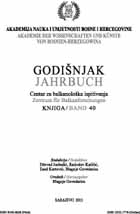Il sarcofago del duca Branimir
Duke Branimir’s Sarcophagus
Author(s): Ante MiloševićSubject(s): Archaeology
Published by: Akademija Nauka i Umjetnosti Bosne i Hercegovine
Summary/Abstract: According to old sources, on 6 March 1891, on Crkvina in Biskupija near Knin, where the remnants of St. Mary’s Church and the palatium of Croatian rulers are situated, a stone sarcophagus was excavated in the deepest strata of the northern part of the nartex (“lobby and morgue” - the area marked as the ruler’s mausoleum in the ground floor of the Westwork). Based on an analysis of the data on the find and on a comparison of three significant elements (gold-plated spurs with Carolingian features, with a set of fittings mostly adorned with Christian motifs, produced by local workshops in the second half of the 9th century; a stone sarcophagus carved out of a massive Roman architrave with remnants of a high-quality relief of two opposite hypocampi in an elaborated framework; a sarcophagus lid with a carved flat Latin cross with branching upper arms which are reminiscent of a ruler’s crown), along with the gold coins of Constantine V Copronymus and his son Leo IV from the Syracuse mint (between 760 and 775 AD), the author believes that this monument of Croatian cultural and historic heritage should be considered as Duke Branimir’s sarcophagus dated at the end of the 9th century. The author concludes that the sarcophagus from Crkvina, on whose lid a Latin cross with branching arms was carved, was also manufactured in a stonemason’s workshop operating in Dalmatia, according to comparative data, at the time of Duke Branimir’s rule. The sarcophagus was buried in the mausoleum, on the ground floor of the Westwork of St. Mary’s Church. This church was situated within the complex of the then rulers’ court. Since not only gold coins of Constantine V Copronymus and Leo IV, and a goldplated jasper pendant, nowadays lost, have been recovered, but also luxurious gold-plated bronze spurs with Carolingian features, the fittings of which were adorned with various forms of crosses, also with recognisable branching arms on the prick of the spurs, it seems entirely justified to assume that this early mediaeval Croatian ruler was buried in that sarcophagus. Duke Branimir’s sarcophagus, recognised in this manner, becomes a very important national monument. Therefore, in the entirety of the Croatian early mediaeval archaeological heritage, this sarcophagus should be particularly and markedly celebrated, and appropriately treated in the future new collection of the Museum of Croatian Archaeological Monuments.
Journal: Godišnjak Centra za balkanološka ispitivanja
- Issue Year: 2011
- Issue No: 40
- Page Range: 221-242
- Page Count: 22
- Language: Italian

